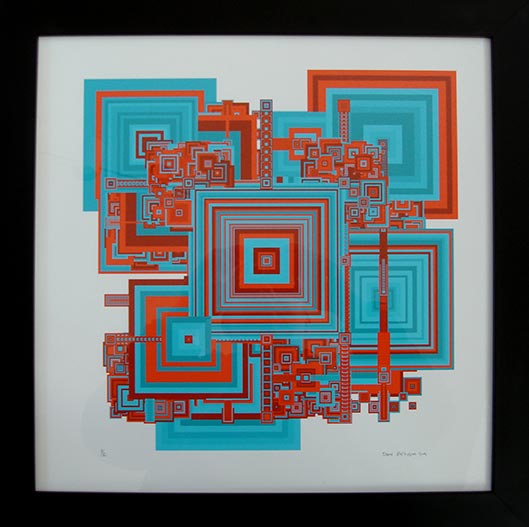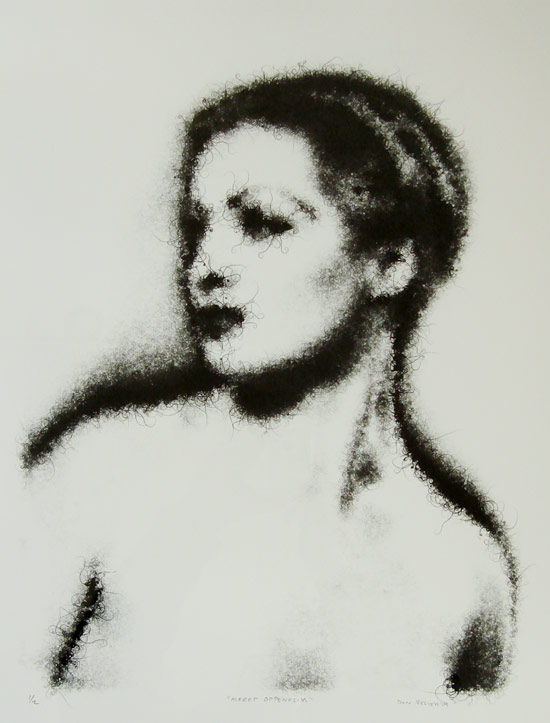Art Projects
Generative Video
Artist Info / CV
Screensavers
evilcomputergenius
Resume
Blog 2005-2010
Blog
About
Don Relyea's Blog
I like to write about interesting art projects,
so give me a heads up if you have new project
and I'll write about it.
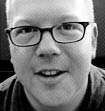
Don Relyea
email:
don(at)donrelyea.com
- art (215)
- baby (10)
- ebay (10)
- fossils (1)
- funny (4)
- general (15)
- kids (2)
- koi_pond (9)
- music (30)
- net_activism (1)
- photography (2)
- pmmg (2)
- screensavers (7)
- technology (2)
- video_art (23)
Blog RSS Feed

Art RSS Feed

Music RSS Feed

Screensavers RSS Feed

Add my blog to your
Google home page

Blogs:
Chris Ashley
Tom Moody
BLDG blog
Walker Art Center
turbulence.org
collisiondetection.net
She Dreams in Digital
kevan.org
2blowhards.com
thinking about art
artblog.net
the generator blog
The Presurfer
Mike Butler
Erik Smartt
patentlysilly.com
angrypirate.com
Chris Jagers
Paperback Writer
lifehacker
Mark Gould
asquare.org
m.d. mcmullin
amovablefeast
accuracy and aesthetics
phawker.com

Bombshell

Agendas Under Fire

110th Assembly

Meret Oppenheim portrait

Image Reconstruction

Ready Made Glitch

Slit Scan 3d Images

Systemic Sky

Slit Scan Photography

Monochrome Generator

Space Filling Curve Art

Hair Particle Drawing
Arts and New Media
Sect of Homokaasu
Roman Verostko
Jared Tarbell
Marius Watz
Juergen Schwietering
MIT Media Lab
eyebeam.org
ARS Electronica
mocoloco.com
rhizome.org
runme.org
core77.com
IAAA
furtherfield.org
Cory Arcangel
Philip Galanter
Roy Stanfield
Adrian Ward
ambienttv.ne
Alex Dragulescu
toxi
generator x
database of virtual art
Blast Theory
Institute for Applied Autonomy
0100101110101101.org
Bathsheba Grossman
Ariel Malka
BLF
Art Crimes
Buff Monster
Hactivist
rtmark
Faile
Mute
Crumb
the Yes Men
Marcel
X257.com
moma
amoda.org
artforum
metropolismag.com
neural.it
EFF
{G2}
Kate Armstrong
no-org.net
mnartists.org
Casey Reas
Vlad_Nanca
digitalsouls
Transmediale
Media Art Net
treasurecrumbs
Art Interactive
Electronic Arts Intermix
artsjournal
MTAA
Suzanne G
onreact
Wooster Collective
computergraphica.com
hardisco.com
inhabitat.com
c505
recyclart
ultra eczema
Kris Davidson
Robert Spahr
drainmag.com
Thor Johnson
Sat, 16 Jan 2010
The Aikon Project: computational drawing system
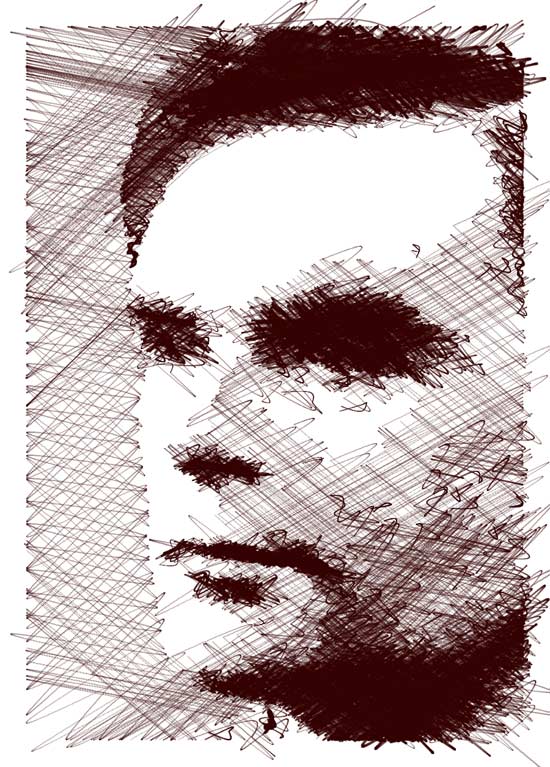
Alan Turing, 23 June 1912 – 7 June 1954. (Aikon, 2010)
Goldsmiths University of London has a great project called the Aikon Project. They have been awarded a grant to explore artistic drawing focusing on portraits. The Aikon Project is supported by a Leverhulme Trust 3 year research grant.
From their web site..."What can explain that for a non-draughtsman it proves so difficult to draw what they perceive so clearly, while an artist is able to do so sometimes just with a few lines, in a few seconds? Furthermore, how can an artist draw with an immediately recognizable style/manner? How can a few lines thrown spontaneously on paper be aesthetically pleasing? "
The sketch of Alan Turing above is really nice, it appears to be drawn with a single line. I love how at the point where the line takes a turn the lines weight gets a bit heavier just like it would with a felt tip pen.
From their web site..."The main objective of our investigation is to implement a computational system capable of simulating the various important processes involved in face sketching by artists. The ensemble of processes to be simulated, including; the visual perception the subject and the sketch, the drawing gestures, the cognitive activity: reasoning. the influence of the years of training, etc., the inter-processes information flows. "
The Aikon Project is very interesting to me as I have a similar one. I have been evolving my Hair Particle Drawing Project into a plain old particle drawing project that will employ a variety of types of marks, open cv, face recognition, etc. My strategy is to keep the particle framework and modify the particle classes to accommodate several marks, continuous line regions, erasing, emphasis, etc. I plan to use the face recognition libraries to determine where to place the really important lines and add extra emphasis. I have been reflecting a lot on how I draw in real life for this project and I have been trying calculate ways to approximate this process based on my own experience.
I am not as far along though and right now I only have some hatching, erasing and emphasis going on. Below is some output from last Fall.
Our British friends at Goldsmiths are basing a lot of their work on archives of sketches and artists notes so I imagine they will have a lot more information to feed their computational drawing system. I really look forward to following the progress of this project. They have a mailing list you can sign up for on their web site if you are interested in following it as well.
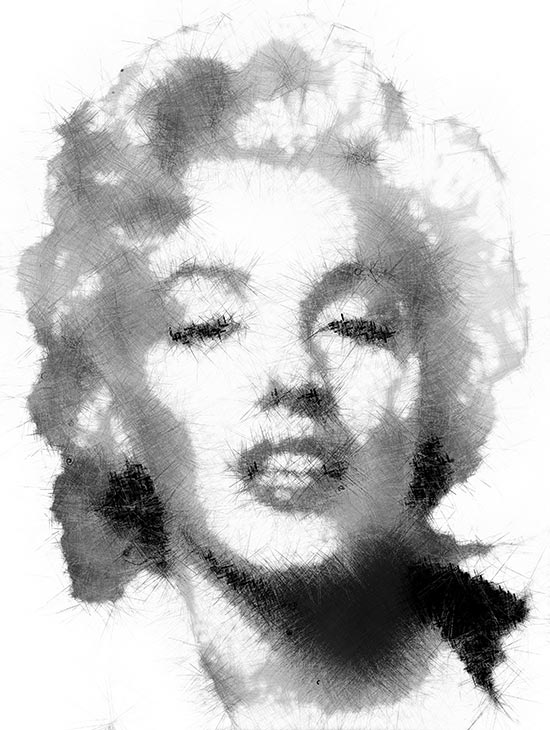
Marilyn Monroe, Don Relyea, Particle Drawing Project, 2009
Jen Stark hand cut paper sculptures and drawings
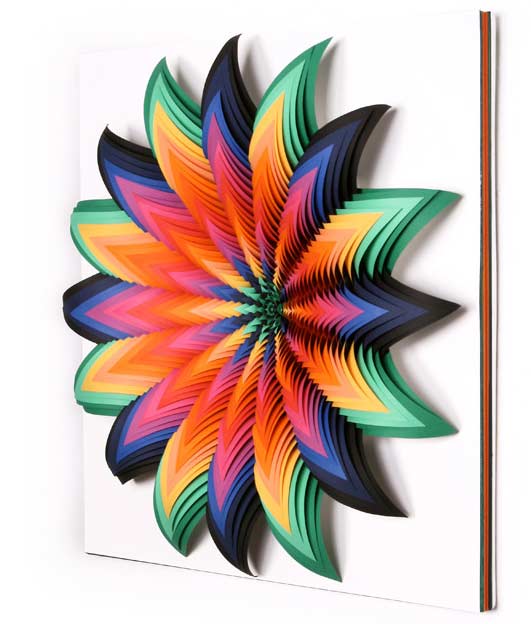
Jen Stark, Prismacolor, hand cut paper 2009
I ran across Jen Stark's work a while back somewhere and then ran across it again while reading a friends blog the other day and meant to post on her work.
Stark is primarily known for her hand cut paper sculptures but she also draws and designs. Her use of color is smart and well done.
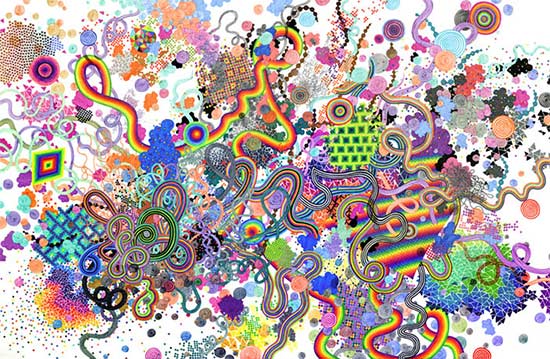
Jen Stark, High on Constellation, felt tip pen on paper, 2009
Stark's hand cut paper works and her drawings exhibit a great natural use of pattern as well. Be sure to visit her site. Her entire site is very well done, reminding me I have been meaning to clean my site up a bit this year as well =)
Wed, 13 Jan 2010
401_06 in Moscone Center and Meret Oppenheim at LAL Nude 2010
"401_06" from my Space Filling Curve project at the Mathematical Art Gallery in Moscone Center, San Francisco, CA. January 13-16, 2010, as part of the 2010 American Mathematical Society - Mathematical Association of America Joint Mathematics Meetings.
"Meret Oppenheim" from my Hair Particle Drawing Project will be on display at Nude 2010 January 16 – March 28, 2010 at the Lexington Art League galllery, Lexington Kentucky.
I received a lot of questions about the Meret Oppenheim piece from LAL and I thought I would share my commentary on the piece here as well.
The Meret Oppenheim piece was developed in C++ using Openframeworks.
Meret Oppenheim was the the artist loosely associated with the Dada movement who made the very famous fur lined teacup. The photo this image is sampled from was taken in 1937 by Man Ray. I thought Meret Oppenheim would be a great subject for a hair particle drawing project.
My "blank canvas" looks a little different from the usual artists "blank canvas". I create my work in a software compiler ( Code Blocks ) so my "blank canvas" looks more like a word processor. Only when the program is executed is the visual output realized.
The hair particles are not real hair but virtual approximations of growing hair generated by my software. I have several works using this drawing engine. It is based around a particle fx engine I wrote for a game some time ago. I altered the particles to behave like growing hair. In the early stages of development the particles rendered long and flowing hair with loose curls. In general, hair growing in darker areas grows longer, thicker and maintains a tighter curl. This is to preserve some of the detail that would get overgrown otherwise. Hair will continue to grow over time.
What is a hair particle? Video games are a good context to think about particles. When something explodes in a video game, debris flies everywhere. The debris is described visually using particles that keep track of various properties such as velocity, physics, scale, luminosity, color etc as the debris flies across the screen. Particles in the context of the Hair Particle Drawing Project can be thought of the same way but instead of a explosion metaphor, imagine 10's of thousands of pencils or dry point tools emanating from everywhere leaving a mark on the drawing plane to draw the portrait all at once. The particles are capable of behaving on their own and no two will ever behave exactly the same.
- July 2011 (1)
- December 2010 (1)
- November 2010 (2)
- October 2010 (2)
- July 2010 (2)
- June 2010 (1)
- May 2010 (1)
- April 2010 (1)
- March 2010 (3)
- February 2010 (3)
- January 2010 (3)
- December 2009 (1)
- November 2009 (3)
- October 2009 (2)
- September 2009 (4)
- August 2009 (3)
- July 2009 (2)
- June 2009 (3)
- May 2009 (2)
- April 2009 (1)
- March 2009 (7)
- February 2009 (1)
- January 2009 (3)
- December 2008 (3)
- November 2008 (4)
- October 2008 (5)
- September 2008 (2)
- August 2008 (5)
- July 2008 (4)
- June 2008 (3)
- May 2008 (3)
- April 2008 (2)
- March 2008 (7)
- February 2008 (9)
- January 2008 (5)
- December 2007 (2)
- November 2007 (5)
- October 2007 (5)
- September 2007 (3)
- August 2007 (4)
- July 2007 (3)
- June 2007 (5)
- May 2007 (8)
- April 2007 (37)
- January 2007 (6)
- December 2006 (7)
- November 2006 (9)
- October 2006 (11)
- September 2006 (12)
- August 2006 (12)
- July 2006 (7)
- June 2006 (5)
- May 2006 (5)
- April 2006 (4)
- March 2006 (8)
- February 2006 (4)
- January 2006 (9)
- December 2005 (3)
- November 2005 (3)
- October 2005 (6)
- September 2005 (9)
- August 2005 (11)
- July 2005 (9)
- June 2005 (14)
- May 2005 (3)
